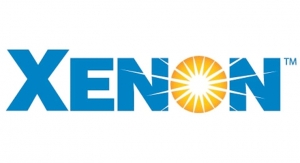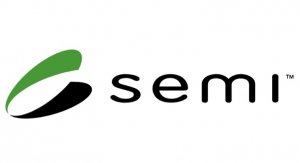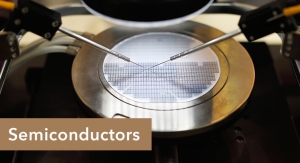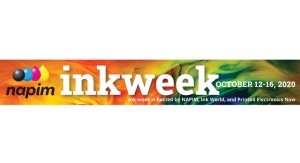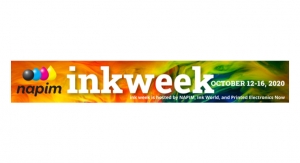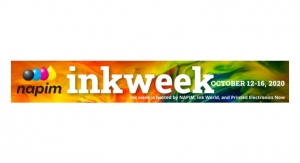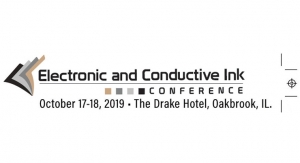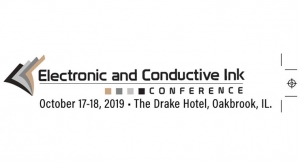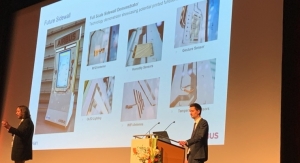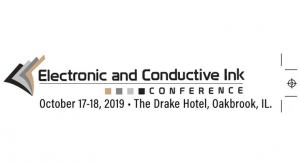David Savastano, Editor10.23.19
Flexible and printed electronics applications are increasingly appearing in commercial applications every day, from wearables for healthcare to smart packaging, sensors, automotive tail lights and displays, flexible displays, photovoltaics and more, with more products coming fast through the pipeline.
The potential applications for the flexible and printed electronics industry appear to be virtually endless, and electronic and conductive inks are essential to this fast-growing technology. Estimates place the conductive ink field at $2.5 billion. To meet the needs of this growing field, conductive ink manufacturers are working on new high-tech materials.
These were some of the key takeaways from industry leaders during the 2019 Electronic and Conductive Inks Conference. The conference was held Oct. 17-18 at The Drake Hotel in Oak Brook, IL, in conjunction with the National Association of Printing Ink Manufacturers’ (NAPIM) annual NPIRI Technical Conference. It is co-sponsored by NAPIM and Rodman Media, publishers of Ink World Magazine and Printed Electronics Now.
The opening session of the conference was moderated by Lisa Fine of Ink Systsems, Inc., and was a joint session with NPIRI. The session began with “The Technologist’s Guide to Printed Electronics,” the Keynote Talk given by Dr. Erika Rebrosova, electronic materials technology manager for Sun Chemical, Advanced Materials Group.
Dr. Rebrosova noted that rigid PCB solutions are still dominating the electronics market, but there is a clear trend of increasing use of flexible circuits in multiple markets.
“They are more conformable, easier to integrate and provide better performance to fit electronics and flexible applications,” Dr. Rebrosova added. “They are found in consumer electronics, human machine interfaces (HMI), automotive, wearables, medical electronics and lighting.”
She noted that printed flex primarily utilizes silver, is an additive process and can be used on many substrates.
“The basic value proposition for printed electronics (PE) is that by using additive processes, instead of subtractive processes, you can lower complexity and cost of manufacture and improve environmental impact,” Dr. Rebrosova pointed out. “Printed keyboards and heaters use this. PE also includes a lot of enabling technology for integration of electronics and adding new form factors and features.”
So why is printed electronics not more mainstream?
“Many expected silver flex technology to improve and deliver faster,” she said. “This is a high-tech era and crude systems are not exciting. There is also a lack of standardization.”
Hybrid electronics, combining printed and conventional silicon technologies, is proving to be a strong alternative.
“One misconception was that all of the components can be printed,” Dr. Rebrosova said. “As a result, expectations were overinflated. Not all circuit components can be printed – there is a need to work with rigid components, silicon ICs and batteries. Hybrid flex offers an opportunity to combine the benefits of both worlds and bridge cost and performance.”
“There are a lot of applications in hybrid electronics,” added Dr. Rebrosova said. “There are some successful applications – membrane and capacitive switches, glucose sensors, EL lighting , automotive sensors and heaters, RFID antennas, RFID/NFC sensors. Collaboration is key to move new technologies to commercialization. There are some ASTF standards for PTF inks, and some need to be adapted or developed.”
As for conductive inks, screenprinting still dominates the PE space, and inkjet is growing.
“We need better conductivity, finer lines and pitch, and new form factors – conformability, stretchability, 3D form factors, faster speed printing, and faster drying time,” she said. “The majority of conductive inks are solvent-based and thermally curable. UV conductive ink is a holy grail – there are some on the market but are used sporadically.”
Next up, Robert Waldrop, printed electronics business development and distribution manager, DuPont Advanced Materials, discussed “Stretching the Boundaries of Printed Electronics,” a look at the history of printed electronics.
Waldrop has been in the printed electronics field for 34 years, noting that DuPont was involved in the development of the first rear window defrosters using a silver grid for the Buick Riviera. He noted that screenprinted silver inks were developed by DuPont as far back as 1948.
“By 1961, we had developed screen printed resistors,” he added. “In 1984, Solamet PV metallization was introduced. By, we were working on printed biosensors for blood glucose monitoring. In 1998, we had developed our Luxprint screenprinted electroluminescent light and our Heatel printed heaters.”
Waldrop then focused on what is new, including wearables and in-mold electronics. For example, DuPont’s Intexar smart clothing technology can be found in Ralph Lauren jackets and wearables from Owlet and Wimu.
“In-mold electronics have up to 30% lower cost, but there is a hesitancy to change by OEMs. Appliances are capacitive touch rather than membrane switch now. In-mold electronics has been re-adopted in the automotive world – it’s in cars now. We think it is coming,” Waldrop said. “You need the supply chain to be able to meet the neds of Tier 1’s and OEMs.”
Casey Grenier, Ph.D., material scientist, R&D division of Tekscan, Inc., followed with “Applications for Tekscan’s Printed Force Sensor Technology, and the Inks That Make Them.”
Tekscan’s products are found in a wide range of products, from sensors in Dr. Scholl’s store kiosks and throttle handles for Johnson Marine motors. Dr. Grenier noted that Tekscan’s sensors are being embedded in medical devices, and are affordable, reliable, comfortable and easy to use.
“This is not a new technology. We’ve been around since 1981,” Dr. Grenier noted. “We have printed several million sensors and served 18,000 customers.”
The company uses screenprinting for its sensors.
“Screens are used to deposit layers of conductive, force sensitive and dielectric materials, down to 5 mil lines,” noted Dr. Grenier. “Our FlexiForce sensors are printed on Kapton. They are as accurate as they need to be, can be calibrated and are durable to well over one million cycles.”
Vikram Turkani, applications engineer at NovaCentrix, discussed the compnay’s Metalon copper inks in his talk on “Conductive Copper Inks and Non-Equilibrium Thermal Processing to Achieve Optimized Performance on Temperature Sensitive Substrates.”
He noted that NovaCentrix acquired Intrinsiq Material’s copper and copper oxide inks and pastes, adding that these inks can be printed with a variety of techniques, incudign inkjet, Aerosol Jet and screenprinting.
Chris Booher, chief marketing officer, ChemCubed, closed the joint session with his talk on “It’s More About the Ink Than You Think.”
Booher noted that every application ChemCubed has worked on has been different. “No two have been the same,” he added. “We do custom chemistries for UV curable nanocomposite and non-UV curable liquids across multiple 3D and digital printing technologies. Our customers are moving from traditional processes to advanced processes.”
Booher then focused on ElectroJet, ChemCubed’s nanoparticle-free silver conductive inks and dielectrics, as well as key advantages, such as component miniaturization and the ability to do proof of concepts fast.
“Market applications include printed circuitry, circuit boards, electronic packaging, displays, flexible hybrid electronics, wiring harnesses passive components, RFID, sensors, shielding and antennae applications, semiconductor manufacturing, PV and wearables,” he observed. “We are working with an aerospace customer on resistors and capacitors, and did proof of concept.
“It’s more about the ink than you think,” Booher added. “There are nanoparticle, silver paste/flake, carbon-based and particle-free options. Not all printers can run every ink. ElectroJet particle-free inks offer excellent adhesion to multiple substrates, low sintering temperatures at 80°C, with near bulk conductivity of 10-8 resistivity. They work with Ricoh, Konica Minolta, Fuji Dimatix, Epson, Mimaki, IDS NanoJet and Optomec Aerosol Jet printers.
ChemCubed has also launched its own ElectroUV30 UV LED flatbed inkjet printer, which is a full turnkey system. “We are finding that we need to get people to go into the printing process so companies can do proof of concept,” Booher concluded.
After lunch, the afternoon session was moderated by Brogan Gust of Inksolutions LLC. XENON Corporation CEO Lou Panico opened the session with “Low Temperature Photonic Sintering for Printed Electronics.”
“Pulsed light is our core technology,” Panico said. “It is our core technology. There are more than 4,000 XENON pulsed light systems running 24/7 worldwide. Pulsed light delivers very high energy pulses in extremely short periods of time, 1 megawatt pulse for 1 micro second, and the peak power phenomenon allows for deeper penetration depths.”
“Photonic sintering is right for PE – it can take place in fractions of seconds and is a non-contact process,” Panico added. “It is also a low temperature process. I think PE will be bigger than transistors. We are working on developing new lamps and creating and nourishing partnerships, and we work with many conductive nanoparticles for printed electronics needs.”
Dr. Vijaya Kayastha, lead device development engineer, Brewer Science, Inc., followed with a look at Industry 4.0 Warehousing in his talk on “Role of Materials in Performance of Printed Temperature Sensors.”
“Temperature is a key environmental factor to monitor and control,” Dr. Kayastha pointed out. “Monitoring temperature in Industry 4.0 warehousing projects protects against un-necessary loss. Sensors can monitor temperature conditions in different zones in your warehouse, while also controlling access. Brewer’s 8-channel temperature sensor array also offers a data acquisition system.”
Brewer Science’s Printed Temperature Sensor is a resistive type that uses screen printed silver ink and has a flexible form factor. Dr. Kayastha noted the advantages of printed temperature sensors.
“There are a lot of temperature sensors in the market,” he observed. “Printing is low cost, scalable manufacturing, and can have unlimited customization. It can be configurable into a sensor array at a high speed of 200 meters per second.”
Dr. Stephanie Harvey, SEMI’s R&D program manager, followed with her talk on “From Wellness to Medtech: The Role of Flexible, Printed Electronics in Wearables and Beyond.”
Dr. Harvey noted that a wearable is an electronic device that augments human senses or capabilities that is worn on an individual. She said that the first self-winding watch ap-peared in 1770, the first hearing aid in 1888 and the first commercial pedometer in 1965. In reality, not much has changed.
“There isn’t a lot of difference in form factors other than miniaturization of components,” Dr. Harvey said. “Human form factors haven’t changed. Technology evolution is needed but in wearables it has been incremental.”
“Fashion designers and electronic designers are now beginning to collaborate,” she added. “In addition, the medical market is changing from focused on the doctor to patient-centric. It is personalized and decentralized. There are opportunities like patches, which has con-sumer familiarity and no electronic interface is needed. Wearables do not have sufficient market pull yet but medical technology may have it.”
Stewart Rissley, sales account manager, wet grinding & dispering for Bühler Inc., discussed pre-dispersing prior to milling in his talk on “Advanced Technology and Process for Inks.”
“For inkjet conductive ink, there are great challenges due to metallic particles clogging the printheads,” Rissley pointed out. “Bead milling is the way to go as grinding media does the work. The key is pre-dispersing the solution.”
Oshadha Ranasingha, research assistant professor at the Department of Electrical and Computer Engineering, University of Massachusetts Lowell, closed the firdst day with his talk on “Dielectric, Ferroelectric and Resistive Inks Based on Barium Strontium Titanate (BST): Formulation, Characterization and Applications.”
“With functional inks, the key element is functional materials such as nanoparticles and polymers,” Ranasingha noted. “We have to build a recipe for the functional inks.”
One of the key motivations for the new ink is tunability, which is important in many RF/microwave applications. There are opportunities for tunable applications, including military and RF.
“BST can provide tunability by using an electric field to change the dielectric constant,” Ranasingha said. “BST offers up to 15% tunability, and is compatible with several printing technologies.”
Afterward, there was a reception and tabletop exhibition.Afterward, there was a reception and tabletop exhibition, featuring the following exhibitors: Buhler, Inc.; ChemCubed; DPI/CMC/Myers Mixers; EMI - Engineered Mills, Inc.; Harper Corporation of America; Liquid Wire, Inc.; Metallograph Division, SPF-Inc.; NAPIM; NovaCentrix; Printed Electronics Now; Sun Chemical Advanced Materials; and Xerox Research Centre of Canada.
On Oct. 18, John Copeland, NAPIM’s executive director, moderated the session, which led off with Bill Babe, sales and marketing manager, Liquid X Printed Metals, who covered “Particle-Free Inks: Enabling Next Gen Printed Electronics Directly on Textiles.”
Babe noted that Liquid X’s functional inks are particle-free, which is ideal for inkjet printing as it does not clog printheads, and provides uniform coating and smooth film traces.
“We are getting there on E-textiles,” Babe noted. “You don’t feel our ink on the fabric, and we are keeping conductivity through 100 wash cycles.”
Liquid X is working on a number of E-textile applications, including a prototype of a compression sleeve with ECG testing for a customer, and diabetes sensors with Bonbouton.
“It has to be viable from a commercial perspective,” Babe noted. “We have apps in health and wellness monitoring, user comfort, fashion and defense, as well as passive RFID tracking, energy harvesting and storage (printed batteries), command controls and printed circuits for connectivity.”
George Fuchs, NAPIM’s director of regulatory affairs and technology, provided insights into the regulatory environemnt in his talk on “Nanotechnology: EHS Considerations for Manufacturing and Usage”
“We are now hearing that nanoplastic particles can transfer from the blood brain battery; the only other material we know about is lead,” he said. “We are more concerned about regulatory standards from OSHA and FDA. There is no global harmonization; it can be regulated differently in the US, EU and China.”
Fuchs pointed out that the EPA under TSCA published a mandatory reporting requirement by August 2018, while ECHA in the EU has a deadline of January 2020. “They are concerned about various environmental and health and safety impacts. The public is tremendously risk averse, even about infinitesimal exposure levels,” he added. “Exposure routes can be oral, dermal or inhalation. However, the FDA does not make a categorical judgment that nanotechnology is inherently safe or harmful.”
Dene H. Taylor, Ph.D., president of SPF-Inc., discussed his latest breakthroughs in his talk, “Easy, Fast and Functional! Metallograph® Pure Metal Conductive Printing.”
Metallograph is manufactured by IIMAK, with SPF-Inc as the distributor. Metallograph offers the same values as digital – print-on-demand, very quick changeover, and can print serial numbers on them.
“Metallograph is continuous metal transfer technology, and provides high productivity with very good yields for very low capital investment,” Dr. Taylor reported. “We’ve proven Metallograph. The metal is continuous sputter coated on ribbon to a controlled thickness. The digital printers are off the shelf.”
Dr. Taylor discussed important markets for Metallograph, beginning with RFID, its new chipless RFID and partnership with AstroNova QuickLabel.
“Rain RFID is a proven market, especially when paper, not plastic, is requested,” Dr. Taylor noted. “Interior auto components, low voltage electrical flexible heaters, sensor boxes and LED mounts are some of the other proven uses.”
“In chipless RFID, items are passively connected,” he said. “Chips can be flip-chip or direct die attached with million-dollar machines, or can be assembled inside the package by the printer. We have the ability mount chips; QuickLabel has the ability to put multiple layers down.”
“QuickLabel will be the first narrow web, full system provider to the flexible electronics industry. It brings together the necessary elements of devices, inks, substrates, print quality, ribbon saver, and application expertise,” Taylor said.
I closed the conference with my talk on “Conductive and Electronic Inks – Driving the Flexible Electronics Revolution.” As editor of Ink World and Printed Electronics Now, I have seen a wide range of applications come up over the years, some succeeding (RFID, glucose sensors) while others falling by the wayside (organic photovoltaics, eReaders).
The future does look bright, as smart packaging, RFID, sensors and wearables for automotive and healthcare and more, are quickly reaching commercialization. With these gains, the market for conductive inks will also move ahead.
“As flexible and printed electronics grows, the need for conductive inks will expand as well,” I concluded.
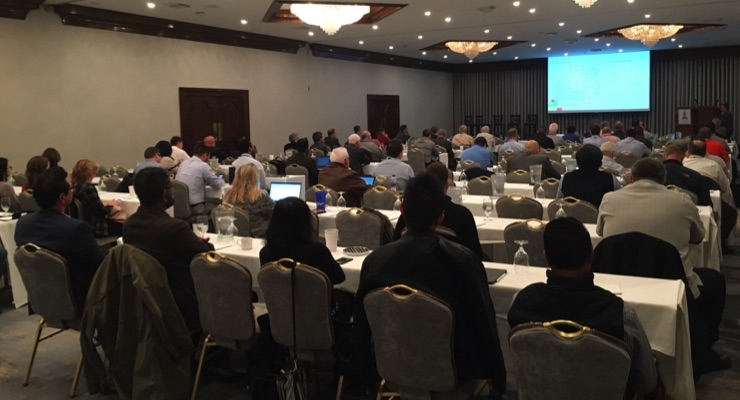
Attendees take in the talks during the 2019 Electronic and Conductive Ink Conference.
The potential applications for the flexible and printed electronics industry appear to be virtually endless, and electronic and conductive inks are essential to this fast-growing technology. Estimates place the conductive ink field at $2.5 billion. To meet the needs of this growing field, conductive ink manufacturers are working on new high-tech materials.
These were some of the key takeaways from industry leaders during the 2019 Electronic and Conductive Inks Conference. The conference was held Oct. 17-18 at The Drake Hotel in Oak Brook, IL, in conjunction with the National Association of Printing Ink Manufacturers’ (NAPIM) annual NPIRI Technical Conference. It is co-sponsored by NAPIM and Rodman Media, publishers of Ink World Magazine and Printed Electronics Now.
The opening session of the conference was moderated by Lisa Fine of Ink Systsems, Inc., and was a joint session with NPIRI. The session began with “The Technologist’s Guide to Printed Electronics,” the Keynote Talk given by Dr. Erika Rebrosova, electronic materials technology manager for Sun Chemical, Advanced Materials Group.
Dr. Rebrosova noted that rigid PCB solutions are still dominating the electronics market, but there is a clear trend of increasing use of flexible circuits in multiple markets.
“They are more conformable, easier to integrate and provide better performance to fit electronics and flexible applications,” Dr. Rebrosova added. “They are found in consumer electronics, human machine interfaces (HMI), automotive, wearables, medical electronics and lighting.”
She noted that printed flex primarily utilizes silver, is an additive process and can be used on many substrates.
“The basic value proposition for printed electronics (PE) is that by using additive processes, instead of subtractive processes, you can lower complexity and cost of manufacture and improve environmental impact,” Dr. Rebrosova pointed out. “Printed keyboards and heaters use this. PE also includes a lot of enabling technology for integration of electronics and adding new form factors and features.”
So why is printed electronics not more mainstream?
“Many expected silver flex technology to improve and deliver faster,” she said. “This is a high-tech era and crude systems are not exciting. There is also a lack of standardization.”
Hybrid electronics, combining printed and conventional silicon technologies, is proving to be a strong alternative.
“One misconception was that all of the components can be printed,” Dr. Rebrosova said. “As a result, expectations were overinflated. Not all circuit components can be printed – there is a need to work with rigid components, silicon ICs and batteries. Hybrid flex offers an opportunity to combine the benefits of both worlds and bridge cost and performance.”
“There are a lot of applications in hybrid electronics,” added Dr. Rebrosova said. “There are some successful applications – membrane and capacitive switches, glucose sensors, EL lighting , automotive sensors and heaters, RFID antennas, RFID/NFC sensors. Collaboration is key to move new technologies to commercialization. There are some ASTF standards for PTF inks, and some need to be adapted or developed.”
As for conductive inks, screenprinting still dominates the PE space, and inkjet is growing.
“We need better conductivity, finer lines and pitch, and new form factors – conformability, stretchability, 3D form factors, faster speed printing, and faster drying time,” she said. “The majority of conductive inks are solvent-based and thermally curable. UV conductive ink is a holy grail – there are some on the market but are used sporadically.”
Next up, Robert Waldrop, printed electronics business development and distribution manager, DuPont Advanced Materials, discussed “Stretching the Boundaries of Printed Electronics,” a look at the history of printed electronics.
Waldrop has been in the printed electronics field for 34 years, noting that DuPont was involved in the development of the first rear window defrosters using a silver grid for the Buick Riviera. He noted that screenprinted silver inks were developed by DuPont as far back as 1948.
“By 1961, we had developed screen printed resistors,” he added. “In 1984, Solamet PV metallization was introduced. By, we were working on printed biosensors for blood glucose monitoring. In 1998, we had developed our Luxprint screenprinted electroluminescent light and our Heatel printed heaters.”
Waldrop then focused on what is new, including wearables and in-mold electronics. For example, DuPont’s Intexar smart clothing technology can be found in Ralph Lauren jackets and wearables from Owlet and Wimu.
“In-mold electronics have up to 30% lower cost, but there is a hesitancy to change by OEMs. Appliances are capacitive touch rather than membrane switch now. In-mold electronics has been re-adopted in the automotive world – it’s in cars now. We think it is coming,” Waldrop said. “You need the supply chain to be able to meet the neds of Tier 1’s and OEMs.”
Casey Grenier, Ph.D., material scientist, R&D division of Tekscan, Inc., followed with “Applications for Tekscan’s Printed Force Sensor Technology, and the Inks That Make Them.”
Tekscan’s products are found in a wide range of products, from sensors in Dr. Scholl’s store kiosks and throttle handles for Johnson Marine motors. Dr. Grenier noted that Tekscan’s sensors are being embedded in medical devices, and are affordable, reliable, comfortable and easy to use.
“This is not a new technology. We’ve been around since 1981,” Dr. Grenier noted. “We have printed several million sensors and served 18,000 customers.”
The company uses screenprinting for its sensors.
“Screens are used to deposit layers of conductive, force sensitive and dielectric materials, down to 5 mil lines,” noted Dr. Grenier. “Our FlexiForce sensors are printed on Kapton. They are as accurate as they need to be, can be calibrated and are durable to well over one million cycles.”
Vikram Turkani, applications engineer at NovaCentrix, discussed the compnay’s Metalon copper inks in his talk on “Conductive Copper Inks and Non-Equilibrium Thermal Processing to Achieve Optimized Performance on Temperature Sensitive Substrates.”
He noted that NovaCentrix acquired Intrinsiq Material’s copper and copper oxide inks and pastes, adding that these inks can be printed with a variety of techniques, incudign inkjet, Aerosol Jet and screenprinting.
Chris Booher, chief marketing officer, ChemCubed, closed the joint session with his talk on “It’s More About the Ink Than You Think.”
Booher noted that every application ChemCubed has worked on has been different. “No two have been the same,” he added. “We do custom chemistries for UV curable nanocomposite and non-UV curable liquids across multiple 3D and digital printing technologies. Our customers are moving from traditional processes to advanced processes.”
Booher then focused on ElectroJet, ChemCubed’s nanoparticle-free silver conductive inks and dielectrics, as well as key advantages, such as component miniaturization and the ability to do proof of concepts fast.
“Market applications include printed circuitry, circuit boards, electronic packaging, displays, flexible hybrid electronics, wiring harnesses passive components, RFID, sensors, shielding and antennae applications, semiconductor manufacturing, PV and wearables,” he observed. “We are working with an aerospace customer on resistors and capacitors, and did proof of concept.
“It’s more about the ink than you think,” Booher added. “There are nanoparticle, silver paste/flake, carbon-based and particle-free options. Not all printers can run every ink. ElectroJet particle-free inks offer excellent adhesion to multiple substrates, low sintering temperatures at 80°C, with near bulk conductivity of 10-8 resistivity. They work with Ricoh, Konica Minolta, Fuji Dimatix, Epson, Mimaki, IDS NanoJet and Optomec Aerosol Jet printers.
ChemCubed has also launched its own ElectroUV30 UV LED flatbed inkjet printer, which is a full turnkey system. “We are finding that we need to get people to go into the printing process so companies can do proof of concept,” Booher concluded.
After lunch, the afternoon session was moderated by Brogan Gust of Inksolutions LLC. XENON Corporation CEO Lou Panico opened the session with “Low Temperature Photonic Sintering for Printed Electronics.”
“Pulsed light is our core technology,” Panico said. “It is our core technology. There are more than 4,000 XENON pulsed light systems running 24/7 worldwide. Pulsed light delivers very high energy pulses in extremely short periods of time, 1 megawatt pulse for 1 micro second, and the peak power phenomenon allows for deeper penetration depths.”
“Photonic sintering is right for PE – it can take place in fractions of seconds and is a non-contact process,” Panico added. “It is also a low temperature process. I think PE will be bigger than transistors. We are working on developing new lamps and creating and nourishing partnerships, and we work with many conductive nanoparticles for printed electronics needs.”
Dr. Vijaya Kayastha, lead device development engineer, Brewer Science, Inc., followed with a look at Industry 4.0 Warehousing in his talk on “Role of Materials in Performance of Printed Temperature Sensors.”
“Temperature is a key environmental factor to monitor and control,” Dr. Kayastha pointed out. “Monitoring temperature in Industry 4.0 warehousing projects protects against un-necessary loss. Sensors can monitor temperature conditions in different zones in your warehouse, while also controlling access. Brewer’s 8-channel temperature sensor array also offers a data acquisition system.”
Brewer Science’s Printed Temperature Sensor is a resistive type that uses screen printed silver ink and has a flexible form factor. Dr. Kayastha noted the advantages of printed temperature sensors.
“There are a lot of temperature sensors in the market,” he observed. “Printing is low cost, scalable manufacturing, and can have unlimited customization. It can be configurable into a sensor array at a high speed of 200 meters per second.”
Dr. Stephanie Harvey, SEMI’s R&D program manager, followed with her talk on “From Wellness to Medtech: The Role of Flexible, Printed Electronics in Wearables and Beyond.”
Dr. Harvey noted that a wearable is an electronic device that augments human senses or capabilities that is worn on an individual. She said that the first self-winding watch ap-peared in 1770, the first hearing aid in 1888 and the first commercial pedometer in 1965. In reality, not much has changed.
“There isn’t a lot of difference in form factors other than miniaturization of components,” Dr. Harvey said. “Human form factors haven’t changed. Technology evolution is needed but in wearables it has been incremental.”
“Fashion designers and electronic designers are now beginning to collaborate,” she added. “In addition, the medical market is changing from focused on the doctor to patient-centric. It is personalized and decentralized. There are opportunities like patches, which has con-sumer familiarity and no electronic interface is needed. Wearables do not have sufficient market pull yet but medical technology may have it.”
Stewart Rissley, sales account manager, wet grinding & dispering for Bühler Inc., discussed pre-dispersing prior to milling in his talk on “Advanced Technology and Process for Inks.”
“For inkjet conductive ink, there are great challenges due to metallic particles clogging the printheads,” Rissley pointed out. “Bead milling is the way to go as grinding media does the work. The key is pre-dispersing the solution.”
Oshadha Ranasingha, research assistant professor at the Department of Electrical and Computer Engineering, University of Massachusetts Lowell, closed the firdst day with his talk on “Dielectric, Ferroelectric and Resistive Inks Based on Barium Strontium Titanate (BST): Formulation, Characterization and Applications.”
“With functional inks, the key element is functional materials such as nanoparticles and polymers,” Ranasingha noted. “We have to build a recipe for the functional inks.”
One of the key motivations for the new ink is tunability, which is important in many RF/microwave applications. There are opportunities for tunable applications, including military and RF.
“BST can provide tunability by using an electric field to change the dielectric constant,” Ranasingha said. “BST offers up to 15% tunability, and is compatible with several printing technologies.”
Afterward, there was a reception and tabletop exhibition.Afterward, there was a reception and tabletop exhibition, featuring the following exhibitors: Buhler, Inc.; ChemCubed; DPI/CMC/Myers Mixers; EMI - Engineered Mills, Inc.; Harper Corporation of America; Liquid Wire, Inc.; Metallograph Division, SPF-Inc.; NAPIM; NovaCentrix; Printed Electronics Now; Sun Chemical Advanced Materials; and Xerox Research Centre of Canada.
On Oct. 18, John Copeland, NAPIM’s executive director, moderated the session, which led off with Bill Babe, sales and marketing manager, Liquid X Printed Metals, who covered “Particle-Free Inks: Enabling Next Gen Printed Electronics Directly on Textiles.”
Babe noted that Liquid X’s functional inks are particle-free, which is ideal for inkjet printing as it does not clog printheads, and provides uniform coating and smooth film traces.
“We are getting there on E-textiles,” Babe noted. “You don’t feel our ink on the fabric, and we are keeping conductivity through 100 wash cycles.”
Liquid X is working on a number of E-textile applications, including a prototype of a compression sleeve with ECG testing for a customer, and diabetes sensors with Bonbouton.
“It has to be viable from a commercial perspective,” Babe noted. “We have apps in health and wellness monitoring, user comfort, fashion and defense, as well as passive RFID tracking, energy harvesting and storage (printed batteries), command controls and printed circuits for connectivity.”
George Fuchs, NAPIM’s director of regulatory affairs and technology, provided insights into the regulatory environemnt in his talk on “Nanotechnology: EHS Considerations for Manufacturing and Usage”
“We are now hearing that nanoplastic particles can transfer from the blood brain battery; the only other material we know about is lead,” he said. “We are more concerned about regulatory standards from OSHA and FDA. There is no global harmonization; it can be regulated differently in the US, EU and China.”
Fuchs pointed out that the EPA under TSCA published a mandatory reporting requirement by August 2018, while ECHA in the EU has a deadline of January 2020. “They are concerned about various environmental and health and safety impacts. The public is tremendously risk averse, even about infinitesimal exposure levels,” he added. “Exposure routes can be oral, dermal or inhalation. However, the FDA does not make a categorical judgment that nanotechnology is inherently safe or harmful.”
Dene H. Taylor, Ph.D., president of SPF-Inc., discussed his latest breakthroughs in his talk, “Easy, Fast and Functional! Metallograph® Pure Metal Conductive Printing.”
Metallograph is manufactured by IIMAK, with SPF-Inc as the distributor. Metallograph offers the same values as digital – print-on-demand, very quick changeover, and can print serial numbers on them.
“Metallograph is continuous metal transfer technology, and provides high productivity with very good yields for very low capital investment,” Dr. Taylor reported. “We’ve proven Metallograph. The metal is continuous sputter coated on ribbon to a controlled thickness. The digital printers are off the shelf.”
Dr. Taylor discussed important markets for Metallograph, beginning with RFID, its new chipless RFID and partnership with AstroNova QuickLabel.
“Rain RFID is a proven market, especially when paper, not plastic, is requested,” Dr. Taylor noted. “Interior auto components, low voltage electrical flexible heaters, sensor boxes and LED mounts are some of the other proven uses.”
“In chipless RFID, items are passively connected,” he said. “Chips can be flip-chip or direct die attached with million-dollar machines, or can be assembled inside the package by the printer. We have the ability mount chips; QuickLabel has the ability to put multiple layers down.”
“QuickLabel will be the first narrow web, full system provider to the flexible electronics industry. It brings together the necessary elements of devices, inks, substrates, print quality, ribbon saver, and application expertise,” Taylor said.
I closed the conference with my talk on “Conductive and Electronic Inks – Driving the Flexible Electronics Revolution.” As editor of Ink World and Printed Electronics Now, I have seen a wide range of applications come up over the years, some succeeding (RFID, glucose sensors) while others falling by the wayside (organic photovoltaics, eReaders).
The future does look bright, as smart packaging, RFID, sensors and wearables for automotive and healthcare and more, are quickly reaching commercialization. With these gains, the market for conductive inks will also move ahead.
“As flexible and printed electronics grows, the need for conductive inks will expand as well,” I concluded.

Attendees take in the talks during the 2019 Electronic and Conductive Ink Conference.

